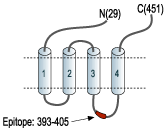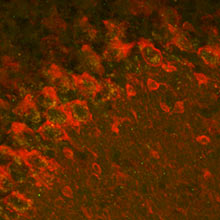Overview
- Peptide (C)TPEPNKKPENKPA, corresponding to amino acid residues 393-405 of rat GABRA2 (Accession P23576). 2nd intracellular loop.

 Western blot analysis of rat brain membranes:1. Anti-GABA(A) α2 Receptor Antibody (#AGA-002), (1:200).
Western blot analysis of rat brain membranes:1. Anti-GABA(A) α2 Receptor Antibody (#AGA-002), (1:200).
2. Anti-GABA(A) α2 Receptor Antibody, preincubated with GABA(A) α2 Receptor Blocking Peptide (#BLP-GA002).
 Expression of GABRA2 in mouse cerebellumImmunohistochemical staining of mouse formalin-fixed frozen cerebellum sections with Anti-GABA(A) α2 Receptor Antibody (#AGA-002). The receptor subunit is localized mainly on the soma of Purkinje cells. Staining with mouse anti-parvalbumin (red) suggests that GABRA2 subunit is restricted to a sub-region of the Purkinje cell.
Expression of GABRA2 in mouse cerebellumImmunohistochemical staining of mouse formalin-fixed frozen cerebellum sections with Anti-GABA(A) α2 Receptor Antibody (#AGA-002). The receptor subunit is localized mainly on the soma of Purkinje cells. Staining with mouse anti-parvalbumin (red) suggests that GABRA2 subunit is restricted to a sub-region of the Purkinje cell.
- Mouse adult hippocampal neural stem cells (1:200) (Quadrato, G. et al. (2014) J. Neurosci. 34, 8630.).
- Owens, D.F. and Kriegstein, A.R. (2002) Nature Rev. Neurosci. 3, 715.
- Whiting, P.J. (1999) Neurochem. Inter. 34, 387.
- Fuchs, K. and Celepirovic, N. (2002) J. Neurochem. 82, 1512.
GABA (γ-aminobutyric acid) is the major inhibitory neurotransmitter in the brain. Its production, release, reuptake and metabolism occur in the nervous system.1
The GABA transmitter interacts with two major types of receptors: ionotropic GABAA (GABAAR) and metabotropic GABAB receptors. The GABAAR belong to the ligand gated ion channel superfamily.2
The GABAAR, is a heteropentamer, with all of its five subunits contributing to the pore formation. To date, eight subunit isoforms were cloned: α, β, γ, δ, ε, π, θ, and ρ.1 Six α subunit isoforms were described to exist in mammals (α1-α6). The native GABAA receptor, in most cases, consists of 2α, 2β and 1γ submit. The α subunit is the most common subunit and is expressed ubiquitously. It determines the affinities for allosteric ligands shown by GABAAR.
α2-Subunit mRNA is strongly expressed only in the hippocampus and the hypothalamus. It occurs very early in rat brain development and declines in adulthood.
The failure to complete the normal transition between the α-subunits that are highly expressed in early development (α2, α3, α5) to those expressed in adulthood (α1) might play a major role in the development of temporal lobe epilepsy.3
Application key:
Species reactivity key:
Alomone Labs offers a highly specific antibody directed against an epitope of the rat GABA (A) α2 receptor. Anti-GABA(A) α2 Receptor Antibody (#AGA-002) can be used in western blot, immunohistochemistry and immunocytochemistry applications. It has been designed to recognize GABRA2 from human, rat and mouse samples.
Applications
Citations
- Mouse RAW264.7 macrophage cell lysate.
Januzi, L. et al. (2018) Cell. Immunol. 332, 7.
- Mouse lung sections (1:200).
Januzi, L. et al. (2018) Cell. Immunol. 332, 7. - Rat DRG sections.
Kannampalli, P. et al. (2017) Neuroscience 346, 349. - Mouse brain sections (1:250).
Skilbeck, K.J. et al. (2018) Pharmacol. Res. 128, 179.
- Mouse adult hippocampal neural stem cells (1:200).
Quadrato, G. et al. (2014) J. Neurosci. 34, 8630.
- Yue, J. et al. (2018) Brain Res. Bull. 137, 156.
- Hanson, J.E. et al. (2013) J. Neurosci. 33, 5924.
